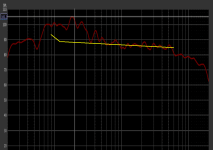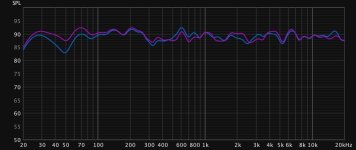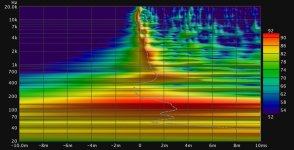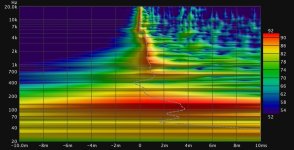My goal for the time being is to get it board flat, then make any adjustments after I’ve lived with it for a few weeks. I’ve got the right channel dialed, I just need to do the same for the left.
Here's a better spectrograph. There's an unfortunate .5ms delay between the tweeter and mid horn that I will just have to live with, but there's significant work that can be done aligning the upper horns with the bass bins. I'd set them at 23" delay, but Roy Delgado, Klipsch's chief engineer had suggested 30" for the JubeScalas, so I will adjust and remeasure later this week.
I never imagined when I began this project that I’d have an issue with too much bass. Yet my partner frequently complained that the bass was too much and after the euphoria of having an abundance of bass wore off, I began to see her point: the low end presence was boomy and on some tracks, it seemed smeared and indistinct. I Found myself constantly adjusting the attenuation on the upper horns- on some tracks, the squawker and tweeter struggled against the bass bins, while on other cuts, it was fatiguing and overly forward. I recently picked up a new DAC, a Schiit Bifrost 2 and a Schiit Loki Mini+ was thrown in at a price I couldn’t refuse. I didn’t plan on hooking it up, but trying it out, I found I could make crude adjustments on the fly to give me a quicker picture of how it should sound and before too long, I’d backed off the bass 3-5dB. That, along with a slight treble booklet from 8000hz definitely steered it in the right direction, so tonight, I opened it up and began removing weight. I’d started out with the full compliment of mass, 7, 75 gram washers or a total of 525g, over half a kilo or a pound and 2-1/2 ounces per cone. Small wonder it was boomy! I removed 2 per unit and sat with it for a while until this evening. I removed one per cone and had my partner making up sign language to describe that it was still too boomy, waving her hands out from her ears back and forth. I removed another washer and got the thumbs up from her, but I have a feeling that I can lose another and sharpen the attack even more without losing impact. At this point, I have 231 grams, close to a half pound per passive, but I’ve also rolled back the bass on the Loki a few dB at 20Hz.
Here’s what I removed, a whopping 304g or 10-3/4 oz per cone.


Measurements to follow. I'll add that what was being experienced wasn't exactly too much bass, the frequency response curves didn't show that, but rather too long of a decay, slow bass, as they say. removing weight has definitely made it quicker, punchier and doesn't necessarily seem to have affected the amplitude, although measurements will be the final tell.
Here’s what I removed, a whopping 304g or 10-3/4 oz per cone.
Measurements to follow. I'll add that what was being experienced wasn't exactly too much bass, the frequency response curves didn't show that, but rather too long of a decay, slow bass, as they say. removing weight has definitely made it quicker, punchier and doesn't necessarily seem to have affected the amplitude, although measurements will be the final tell.
I was also comparing curves from various La Scala, both modded and stock and was disturbed that my measurements didn't either measure up to what I was hearing, or compare favorably to known measurements from the various drivers, particularly the L-MAHL and DE-10 combo.
I downloaded a new copy of the calibration file for my Dayton Audio UMM-6 and remeasured. Red is with the eq generated previously, violet is with a flat peq. Note that the top end measures better than previously. It's small wonder that I was going in circles...

There's the expected dip starting at 60Hz, where the cabinet reaches its limit, but the woofer picks back up around 38 Hz and goes strong to 25 Hz. I have the crossover point for the passive network set at 400, but the woofer is set to 24db at 475 Hz, I suspect the dip at 400-475 is both a function of both the limitation of the PRV D-2200PH, which doesn't really play that low, and perhaps a quirk it the woofer. here are the PEQ recommendations from REW to get it to +/- 2dB:
Bass horn:
Filter 1: ON PK Fc 49.25 Hz Gain 1.20 dB Q 2.006
Filter 2: ON PK Fc 110.5 Hz Gain -4.50 dB Q 2.972
Filter 3: ON PK Fc 241.0 Hz Gain -13.10 dB Q 1.623
Filter 4: ON PK Fc 278.0 Hz Gain 8.10 dB Q 1.305
Filter 1: ON PK Fc 709.0 Hz Gain -4.30 dB Q 3.939
Filter 2: ON PK Fc 1518 Hz Gain -5.30 dB Q 2.620
Filter 3: ON PK Fc 3545 Hz Gain 8.10 dB Q 1.155
Filter 4: ON PK Fc 3711 Hz Gain -12.00 dB Q 1.868
Filter 5: ON PK Fc 8136 Hz Gain -1.80 dB Q 3.318
Given the improved readings, I'm not going to bother with the previously suggested shelf eq for the treble. Stay tuned while I apply the settings and remeasure.
I downloaded a new copy of the calibration file for my Dayton Audio UMM-6 and remeasured. Red is with the eq generated previously, violet is with a flat peq. Note that the top end measures better than previously. It's small wonder that I was going in circles...
There's the expected dip starting at 60Hz, where the cabinet reaches its limit, but the woofer picks back up around 38 Hz and goes strong to 25 Hz. I have the crossover point for the passive network set at 400, but the woofer is set to 24db at 475 Hz, I suspect the dip at 400-475 is both a function of both the limitation of the PRV D-2200PH, which doesn't really play that low, and perhaps a quirk it the woofer. here are the PEQ recommendations from REW to get it to +/- 2dB:
Bass horn:
Filter 1: ON PK Fc 49.25 Hz Gain 1.20 dB Q 2.006
Filter 2: ON PK Fc 110.5 Hz Gain -4.50 dB Q 2.972
Filter 3: ON PK Fc 241.0 Hz Gain -13.10 dB Q 1.623
Filter 4: ON PK Fc 278.0 Hz Gain 8.10 dB Q 1.305
Filter 1: ON PK Fc 709.0 Hz Gain -4.30 dB Q 3.939
Filter 2: ON PK Fc 1518 Hz Gain -5.30 dB Q 2.620
Filter 3: ON PK Fc 3545 Hz Gain 8.10 dB Q 1.155
Filter 4: ON PK Fc 3711 Hz Gain -12.00 dB Q 1.868
Filter 5: ON PK Fc 8136 Hz Gain -1.80 dB Q 3.318
Given the improved readings, I'm not going to bother with the previously suggested shelf eq for the treble. Stay tuned while I apply the settings and remeasure.
alright! Now we're getting somewhere.
this where we began the day. Frankly, it's not as terrible as it seemed previously. but there's room for improvement.

I applied REW's PEQ recommendations:

vs flat:

it's definitely a lot smoother! Still, as I was doing the sweeps, I could hear the dip at 50Hz and the bump at 600Hz. I figure, if I can hear it, it should be adjusted. after a couple runs at it, here's my final result vs the recommended setting:

Vs where we began in green, the recommended eq in blue and the final result in fuchsia:

lastly, the final result all on its own:

as we can see now, it's respectably flat, +/- 3dB from 25Hz (!!!) all of the way up to 20 Hz. Now, I just need to decide if I want to apply something akin to either the Harman or descending curve to the eq. Using my Loki Mini+, it seems I do want to use a Harman style curve, but do I want to use the PEQ to do it or use the device? The Loki is simple enough and gets it done with adjustments at 25Hz, 600 Hz, 2K and 8K, but I'd love to have fewer boxes on my console...
this where we began the day. Frankly, it's not as terrible as it seemed previously. but there's room for improvement.
I applied REW's PEQ recommendations:
vs flat:
it's definitely a lot smoother! Still, as I was doing the sweeps, I could hear the dip at 50Hz and the bump at 600Hz. I figure, if I can hear it, it should be adjusted. after a couple runs at it, here's my final result vs the recommended setting:
Vs where we began in green, the recommended eq in blue and the final result in fuchsia:
lastly, the final result all on its own:
as we can see now, it's respectably flat, +/- 3dB from 25Hz (!!!) all of the way up to 20 Hz. Now, I just need to decide if I want to apply something akin to either the Harman or descending curve to the eq. Using my Loki Mini+, it seems I do want to use a Harman style curve, but do I want to use the PEQ to do it or use the device? The Loki is simple enough and gets it done with adjustments at 25Hz, 600 Hz, 2K and 8K, but I'd love to have fewer boxes on my console...
Attachments
also, looking at the spectrograph, I wonder how that can be improved:

one obvious point is the delay between the tweeter and the squawker, but that would require adding another amp & joining the tri-gang. I do have another one I could use, but I'd prefer to be all valve from the squawker up. I did have a side conversation with @THD+N about another amp to drive the tweeters, but It will be at least until April before I make that move. The bass bin seems all over the place, particularly as it goes into bass reflex.
48 inches is better:

but 56" is better yet:

given that big swing at the crossover point, I wonder if switching the woofer polarity might help? I don't even have to open the box up to try...
flipping the polarity at 56" took care of the delay at the crossover point, but I'm not convinced that it's better on average:

reducing the delay to 48 inches is better with the polarity inverted, but from 200Hz down, it's not so great...

I think 56" with 0º polarity for the woofer is better on average, as it's quite close to the upper horns between 400Hz and 88Hz.

one obvious point is the delay between the tweeter and the squawker, but that would require adding another amp & joining the tri-gang. I do have another one I could use, but I'd prefer to be all valve from the squawker up. I did have a side conversation with @THD+N about another amp to drive the tweeters, but It will be at least until April before I make that move. The bass bin seems all over the place, particularly as it goes into bass reflex.
48 inches is better:
but 56" is better yet:
given that big swing at the crossover point, I wonder if switching the woofer polarity might help? I don't even have to open the box up to try...
flipping the polarity at 56" took care of the delay at the crossover point, but I'm not convinced that it's better on average:
reducing the delay to 48 inches is better with the polarity inverted, but from 200Hz down, it's not so great...
I think 56" with 0º polarity for the woofer is better on average, as it's quite close to the upper horns between 400Hz and 88Hz.
Attachments
You seem to have some acoustic influence to deal with. You don't always want to take response measurements at face value because of that.
s@AllenB I haven't tuned for my room curve just yet, however the time alignment is consistent with other LaScala and variants. Ultimately, I will likely Tri-amp them to bring the tweeter into alignment. My preference would be to use a flea-watt single ended valve amp, but that is likely 6 months off.
- Home
- Loudspeakers
- Multi-Way
- LaScalus, a Horn-Loaded LaScala/Chorus Hybrid



